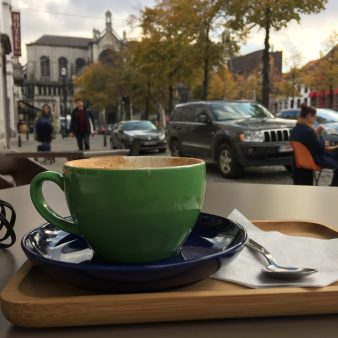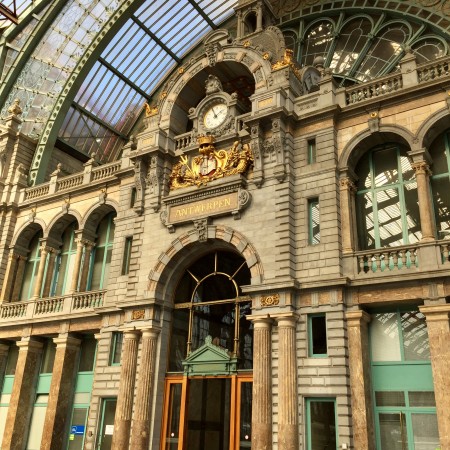Belgium: Home of the Waffle
26 January 2017
So, it’s time to write my second blog post! The topic chosen for this edition is “Identity and Culture: Food and Drink”.
As I’m sitting on the train this morning, from Antwerp back to Brussels, I started to think about what I could write. Luckily, Belgium is the home to some great food, a lot of which we eat in the UK also.

Antwerp Central Station
In fact, last night I ate out at a cool restaurant called Bia Mara. I do not think I could include this in the blog, as it’s a chain of Fish and Chips shops, run by two Irish guys who moved to Belgium. It’s serves quirky versions of fish and chips, like Japanese and Mexican style – but it’s not really Belgian.
Probably the most obvious thing is Belgian chocolate (chocolat Belge)! Here in Belgium, not only can you find entire aisles in the supermarket dedicated to the stuff, but additionally there are chocolate shops on every street. They’re a great place to go if you want to get your hands on a free sample. The biggest chains are Neuhaus, Leonidas, Godiva and Pierre Marcolini. Pierre Marcolini is known for the big shop-front displays at the Sablon store in Central Brussels, here is a picture of its summer decoration.

“Un été chez Pierre” – “A summer at Pierre’s”
Although Belgium may be the argued capital of chocolate, hot chocolates here are a little different to the ones we have back home. Instead of a mixture of cocoa powder, sugar and hot milk, these hot chocolates are melted pure dark chocolate – quite a shock if you’re not expecting it!
The second food snack that Belgium is known for is the waffle (gaufre)! While they may seem the same, there are in fact two types of Belgian waffle; the Brussels waffle and the Liège waffle. The Brussels waffle is more like the ones we find back home – it’s rectangular, crispy on the outside and fluffy in the centre (this texture pairing seems to be something that the Belgians are good at – as you’ll see). They also have a very mild taste, and only lightly sweetened so they are often eaten with whipped cream, sweet sauces, nuts and fruits or even ice cream!
The Liège waffle on the other hand is much chewier and sweeter, it’s also most normally found in a round shape. Because of this it’s often eaten with only a sprinkle of sugar. However, if you ever find yourself in Brussels, head down to the Rue Neuve, where you can find a waffle stand which serves Liège waffles with Belgian milk chocolate baked into the batter – it’s a little pricey but it’s the best!

Can you tell which gaufre is which in the photo above?
These two treats can definitely be considered a Belgian street food, as a waffle stand can be found on every corner, usually serving both types of waffle at prices between €1 and €2.50. Also very popular in Belgium is the Dutch Stroopwafel, this translates literally as “Syrup waffle” and is a harder waffle, with caramel baked inside. These are often enjoyed by being warmed on top of a hot drink before eating them. If you want to try them in the UK, they are often called “Caramel Waffles” can be bought in Lidl, Marks & Spencer and surprisingly, Starbucks.

Also amongst the sweets are a “delicacy” known as cuberdons or gentse neuzen. These are usually found in the North (Flanders), originating from Ghent and are a violet-flavoured jelly inside of a sugar shell. Like Marmite, you either love them or hate them, and I am certainly within the second group!

Finally, in terms of snacks, there are frites (fries). Just like many things, there is a competition between Belgium and France as to whom was the first to invent a certain dish. Contrary to their American name of “French” fries, they are considered to be a Belgian invention. In Belgium, fries really have a cult following – just like at home they are eaten both as a snack and a side to a main meal. However, what distinguishes the Belgian version of fries from the rest is the way in which they are prepared and eaten. To begin, Belgian fries are always double cooked – once at a low temperature and once at high temperature, often in beef fat – to ensure a great taste and that delectable crunchy outside, fluffy inside texture. Next, they are given a sprinkle of salt (never vinegar) and a choice of sauces. This is where you could say that these fries are special – there is the standard ketchup and mayonnaise, but then there is spicy samurai sauce, andalouse, aioli, something called Bickey (I didn’t try this one) and many more.

Frites with mayonnaise and “Sauce frites” from Fritland, Brussels.
The average price for a large portion of fries, with some sauces is around €4. It sounds expensive, compared to the prices we can find in the UK, but the pride that the fritkot owners put into their work really shows in the product. Just like the waffles, chip-shops (fritkots) can be found in every major area of the city. Many fritkots in Brussels and around Belgium claim to have “the best fries”, with loyal followings at each one, but my favourite was undoubtedly “Fritland” at the Bourse in Brussels. In the end, as Belgium is the “homeland” of fries, even McDonald’s does some tasty ones!
Belgium is additionally known for several other dishes, but the most widely-known is probably the moules-frites or mussels and chips. Traditionally, the mussels are cooked in a big casserole dish, in a white wine sauce, but other options such a garlic-tomato sauce or a creamy sauce is also available. This really is a traditional dish, and I would recommend that if you are ever in Belgium (or Scotland for that matter), that you try it. Even if you are not a big seafood fan, the flavour is covered up by the sauce and, of course, the delicious fries!
Can you remember any of the French words for the foods mentioned here?
Moules-frites –
Chocolate –
Gaufre –
Frites –
Fritkot –
What does “Stroopwafel” mean?
What makes Belgian frites different from others?
What is the difference between the two types of Belgian waffle?
In February 2017 I shall be living in Spain, so stay tuned for my updates from there!
Comments
3 comments
Comments are closed.
- December 2025
- November 2025
- October 2025
- September 2025
- August 2025
- June 2025
- May 2025
- April 2025
- March 2025
- February 2025
- January 2025
- November 2024
- September 2024
- August 2021
- March 2021
- January 2021
- December 2020
- October 2020
- April 2020
- March 2020
- February 2020
- January 2020
- December 2019
- November 2019
- October 2019
- September 2019
- August 2019
- July 2019
- May 2019
- March 2019
- February 2019
- January 2019
- December 2018
- September 2018
- August 2018
- July 2018
- June 2018
- May 2018
- April 2018
- March 2018
- February 2018
- January 2018
- December 2017
- November 2017
- October 2017
- September 2017
- August 2017
- July 2017
- June 2017
- May 2017
- April 2017
- March 2017
- February 2017
- January 2017
- December 2016
- November 2016
- October 2016
- September 2016
- August 2016
- July 2016
- February 2016
- October 2015
- September 2015
- August 2015
- May 2015
- March 2015
- February 2015
- January 2015
- December 2014
- November 2014
- September 2014
- August 2014
- July 2014
Great blog Liam.
The Brussels gaufre gets my vote!
Hi Liam,
Lovely to read your blog! I am now starving, I see that we have triple cooked chips at home – yuck!
So off to Spain next. I’m taking it that you are in a French speaking part of Belgium. What is the linguistic split of the country?
Routes Cymru are busy preparing the Pupil Language Ambassador Training Days for Wales – your presence will be sorely missed!
All the best and look forward to reading your Spanish Blogs.
Hi Elen
I’m in Brussels so in the “bilingual” city. I hope all is going well at Routes this year – I will keep you all up to date in Spain!
Liam